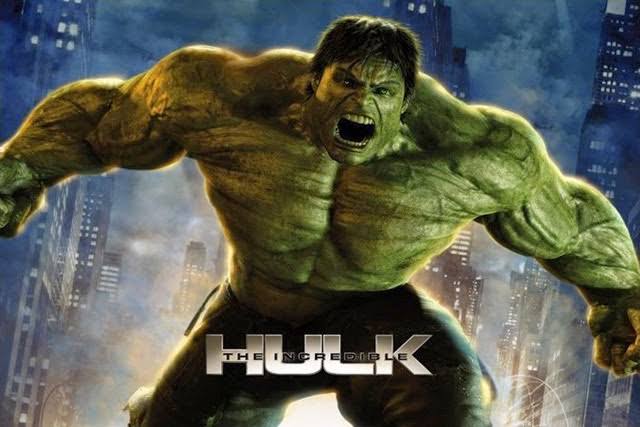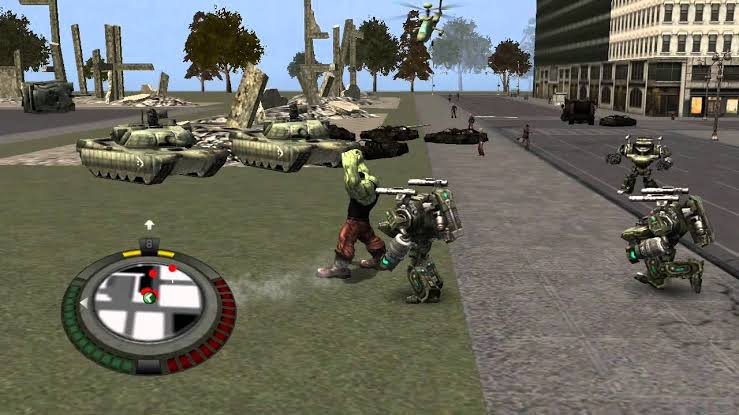The Incredible Hulk is a computer game dependent on the Marvel hero Hulk and the 2008 film. The comfort adaptations were discharged on June 5, 2008 and the PC rendition was discharged on June 10, 2008. Edge of Reality built up the reassure variants while Amaze Entertainment built up the handheld adaptation of the amusement.
 The Hulk is an anecdotal hero showing up in American comic books distributed by Marvel Comics. Made by essayist Stan Lee and craftsman Jack Kirby, the character initially showed up in the presentation issue of The Incredible Hulk (May 1962). In his comic book appearances, the character is both the Hulk, a green-cleaned, cumbersome and solid humanoid having a tremendous level of physical quality, and his change inner self Bruce Banner, a physically feeble, socially pulled back, and sincerely held physicist, the two existing as identities free and disdaining of the other.
The Hulk is an anecdotal hero showing up in American comic books distributed by Marvel Comics. Made by essayist Stan Lee and craftsman Jack Kirby, the character initially showed up in the presentation issue of The Incredible Hulk (May 1962). In his comic book appearances, the character is both the Hulk, a green-cleaned, cumbersome and solid humanoid having a tremendous level of physical quality, and his change inner self Bruce Banner, a physically feeble, socially pulled back, and sincerely held physicist, the two existing as identities free and disdaining of the other. Following his coincidental presentation to gamma beams amid the explosion of a test bomb, Banner is physically changed into the Hulk when exposed to enthusiastic worry, at or without wanting to, frequently prompting ruinous frenzies and clashes that confuse Banner's regular citizen life. The Hulk's dimension of solidarity is ordinarily passed on as proportionate to his dimension of displeasure. Ordinarily depicted as a seething savage, the Hulk has been spoken to with different identities dependent on Banner's cracked mind, from a careless, ruinous power, to a splendid warrior, or virtuoso researcher in his very own right. In spite of both Hulk and Banner's craving for isolation, the character has an expansive supporting cast, including Banner's sweetheart Betty Ross, his companion Rick Jones, his cousin She-Hulk, children Hiro-Kala and Skaar, and his fellow benefactors of the superhuman group the Avengers. In any case, his wild power has carried him into strife with his individual saints and others.
Lee expressed that the Hulk's creation was propelled by a blend of Frankenstein and Dr. Jekyll and Mr. Hyde.[3] Although the Hulk's shading has changed all through the character's production history, the most normal shading is green. He has two primary catchphrases: "Mass is most grounded one there is!" and the better-known "Mass SMASH!", which has established the reason for various popular culture images.
A standout amongst the most famous characters in well known culture,[4][5] the character has showed up on an assortment of stock, for example, apparel and collectable things, propelled genuine structures, (for example, amusement stop attractions), and been referenced in various media. Pennant and the Hulk have been adjusted in cutting edge, energized, and video diversion manifestations, including the 1970s The Incredible Hulk TV arrangement (played by Bill Bixby and Lou Ferrigno individually) and in film by Eric Bana, Edward Norton and Mark Ruffalo.

The diversion plays much like The Incredible Hulk: Ultimate Destruction, in view of its free-wander interactivity and its comparable controls. The primary adversaries in the amusement incorporate Abomination, U-Foes, Bi-Beast,The Enclave, and the United States Army driven by General "Jolt" Ross andMajor Glenn Talbot.
The Hulk previously showed up in The Incredible Hulk #1 (cover dated May 1962), composed by author manager Stan Lee, penciled and co-plotted by Jack Kirby,[6][7] and inked by Paul Reinman. Lee refers to impact from Frankenstein[8] and Dr. Jekyll and Mr. Hyde in the Hulk's creation:
It was plainly obvious that [the enormous character the] Thing was the most mainstream character in [Marvel's as of late made superhuman group the] Fantastic Four. ... For quite a while I'd known about the way that individuals were bound to support somebody who was not exactly immaculate. ... It's almost certain that you recollect Quasimodo, however how effortlessly would you be able to name any of the chivalrous, handsomer, progressively fabulous characters in The Hunchback of Notre Dame? And after that there's Frankenstein ... I've generally had a weakness in my heart for the Frankenstein beast. Nobody would ever persuade me that he was the miscreant. ... He never needed to hurt anybody; he only grabbed his agonizing path during a time life endeavoring to guard himself, attempting to deal with the individuals who tried to pulverize him. ... I chose I should get from Dr. Jekyll and Mr. Hyde also—our hero would always show signs of change from his typical personality to his superhuman adjust self image and back again.[9]
Kirby, remarking upon his persuasions in illustration the character, reviewed as motivation the story of a mother who saves her kid who is caught underneath a car.[10] Lee has likewise contrasted Hulk with the Golem of Jewish mythology.[8] In The Science of Superheroes, Gresh and Weinberg see the Hulk as a response to the Cold War[11] and the risk of atomic assault, an understanding shared by Weinstein in Up, Up and Oy Vey.[8] This elucidation relates with other promoted anecdotal media made amid this day and age, which exploited the common sense among Americans that atomic power could create beasts and mutants.[12]
In the introduction, Lee picked dim for the Hulk since he needed a shading that did not recommend a specific ethnic group.[13]Colorist Stan Goldberg, notwithstanding, had issues with the dim shading, bringing about various shades of dark, and even green, in the issue. Subsequent to seeing the primary distributed issue, Lee changed the skin shading to green.[14] Green was utilized in retellings of the starting point, with even reprints of the first story being recolored for the following two decades, until The Incredible Hulk vol. 2, #302 (December 1984) reintroduced the dark Hulk in flashbacks set near the root story. From that point forward, reprints of the principal issue have shown the first dim shading, with the anecdotal standard determining that the Hulk's skin had at first been dark. An exemption is the early exchange soft cover, Origins of Marvel Comics, from 1974, which clarifies the challenges in keeping the dark shading steady in a Stan Lee composed preface, and reprints the birthplace story keeping the dim hue.
Lee gave the Hulk's adjust inner self the alliterative name "Bruce Banner" since he discovered he had less trouble recollecting alliterative names. In spite of this, in later stories he misremembered the character's name and alluded to him as "Weave Banner", a blunder which perusers immediately got on.[15] The disparity was settled by giving the character the official full name "Robert Bruce Banner."
The Hulk previously showed up in The Incredible Hulk #1 (cover dated May 1962), composed by author manager Stan Lee, penciled and co-plotted by Jack Kirby,[6][7] and inked by Paul Reinman. Lee refers to impact from Frankenstein[8] and Dr. Jekyll and Mr. Hyde in the Hulk's creation:
It was plainly obvious that [the enormous character the] Thing was the most mainstream character in [Marvel's as of late made superhuman group the] Fantastic Four. ... For quite a while I'd known about the way that individuals were bound to support somebody who was not exactly immaculate. ... It's almost certain that you recollect Quasimodo, however how effortlessly would you be able to name any of the chivalrous, handsomer, progressively fabulous characters in The Hunchback of Notre Dame? And after that there's Frankenstein ... I've generally had a weakness in my heart for the Frankenstein beast. Nobody would ever persuade me that he was the miscreant. ... He never needed to hurt anybody; he only grabbed his agonizing path during a time life endeavoring to guard himself, attempting to deal with the individuals who tried to pulverize him. ... I chose I should get from Dr. Jekyll and Mr. Hyde also—our hero would always show signs of change from his typical personality to his superhuman adjust self image and back again.[9]
Kirby, remarking upon his persuasions in illustration the character, reviewed as motivation the story of a mother who saves her kid who is caught underneath a car.[10] Lee has likewise contrasted Hulk with the Golem of Jewish mythology.[8] In The Science of Superheroes, Gresh and Weinberg see the Hulk as a response to the Cold War[11] and the risk of atomic assault, an understanding shared by Weinstein in Up, Up and Oy Vey.[8] This elucidation relates with other promoted anecdotal media made amid this day and age, which exploited the common sense among Americans that atomic power could create beasts and mutants.[12]
In the introduction, Lee picked dim for the Hulk since he needed a shading that did not recommend a specific ethnic group.[13]Colorist Stan Goldberg, notwithstanding, had issues with the dim shading, bringing about various shades of dark, and even green, in the issue. Subsequent to seeing the primary distributed issue, Lee changed the skin shading to green.[14] Green was utilized in retellings of the starting point, with even reprints of the first story being recolored for the following two decades, until The Incredible Hulk vol. 2, #302 (December 1984) reintroduced the dark Hulk in flashbacks set near the root story. From that point forward, reprints of the principal issue have shown the first dim shading, with the anecdotal standard determining that the Hulk's skin had at first been dark. An exemption is the early exchange soft cover, Origins of Marvel Comics, from 1974, which clarifies the challenges in keeping the dark shading steady in a Stan Lee composed preface, and reprints the birthplace story keeping the dim hue.
Lee gave the Hulk's adjust inner self the alliterative name "Bruce Banner" since he discovered he had less trouble recollecting alliterative names. In spite of this, in later stories he misremembered the character's name and alluded to him as "Weave Banner", a blunder which perusers immediately got on.[15] The disparity was settled by giving the character the official full name "Robert Bruce Banner."
Enjoy Guyz

